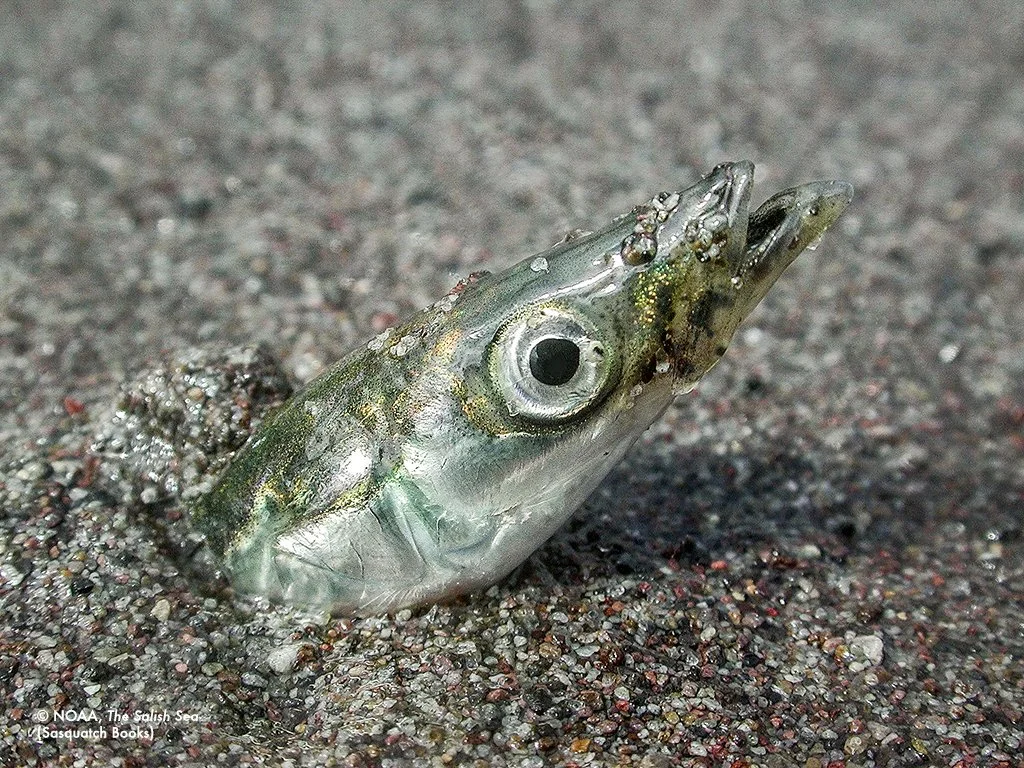Photo by NOAA
By Sarah Teman
Well-aerated, well-sorted, medium-to coarse-grain...” might sound like a wine flavor profile, but it actually describes the type of sandy, sea floor habitat where Pacific sand lance prefer to bury. Lacking a swim bladder, sand lance are unique in their ability to bury themselves to rest and hide from predators. These little eel-like plankton-eating fish play a crucial role in the Salish Sea’s food web, providing nutrition for everything from seabirds to whales, salmon, and lingcod. It’s thought that one sand wave field in the San Juan Archipelago alone could be home to over 12 million sand lance, but we’re only beginning to learn about where they like to hide.
Last month we shared a story about SeaDoc-funded research that used a submersible to measure Pacific sand lance abundance and behavior in the Salish Sea. Two additional recently published SeaDoc-funded, peer-reviewed papers have since come out that help us better understand their sandy seafloor habitat. It’s critical to understand where sand lance live to protect them.
One paper, led by Dr. Gary Greene, helps us better understand how sand waves are structured and survive currents, how they could be affected by seafloor development, and what we stand to lose if they are disturbed. Bringing together data from multiple studies, including using the Cyclops 1 submersible to ground test prior studies, Greene and Team provide a beautiful assortment of images that allow even non-geologists to appreciate the beauty of this unique seafloor habitat. Importantly, they confirmed that Sand Lance prefer to bury in sand wave crests with well-sorted sediment with little skewness and mean size near 0.5-1 mm and near absence of fine silt and clay. This structure likely allows them to bury while still permitting water to flow through it and over their gills so they can breathe. Taking it a step further and with a geologist’s eye, they remind us that sand waves experience sediment transport and human installation of structures like cables and pipelines can have both short and long term consequences that could damage this unique, but critical habitat.
For another study, a team of scientists led by Dr. Clifford Robinson of the Pacific Biological Station (Department of Fisheries and Oceans Canada) used a tool called habitat suitability modeling, to identify where Pacific sand lance burying habitat could be found in the Strait of Georgia and Haro Strait. As it turns out, the distribution and configuration of this habitat vary between the Strait of Georgia in the north and Haro Strait further south. This is likely due to differences in their oceanography and geological processes. This critical habitat has a patchy distribution and ranges widely in size. Further complicating this is the thought that some portion of these sandy habitats where sand lance bury might be seasonal - occurring only in winter in some areas and only in spring-summer in others. Combined, this all would make it challenging for resource managers to protect it if we didn’t have tools like the modeling work done by Robinson and team.
Without studies like these, managers would not have the knowledge nor the tools to identify areas where detrimental human activities–like dredging, trawling, laying cable, or oil spills–could negatively impact Pacific sand lance and the birds, fish and marine mammals that depend on them. Science is not just cool, it helps us take better care of where we live. These studies are critical to understanding the Salish Sea ecosystem and helping to conserve it. SeaDoc supporters make our competitive grants program, which funds projects like these, possible.

